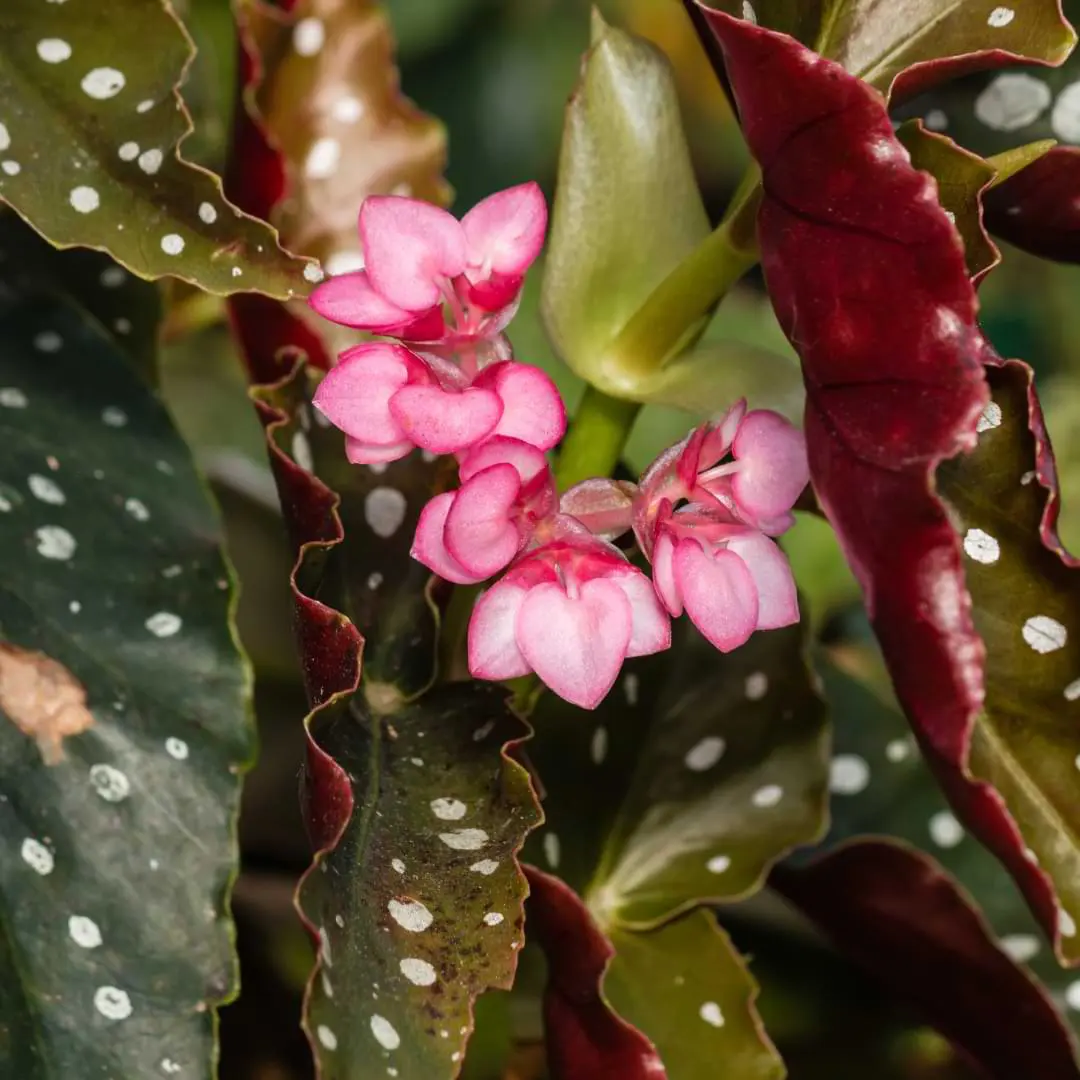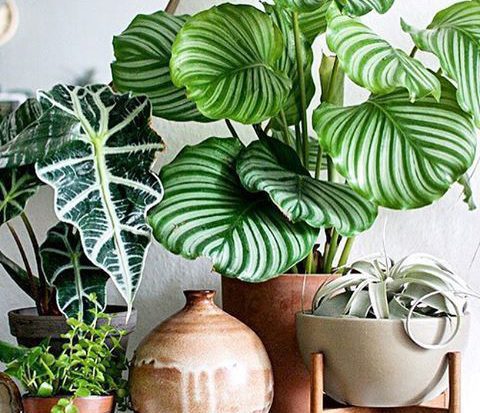Angel wing begonia plant care is surprisingly simple and very rewarding. With proper care, these gorgeous plants will provide clusters of beautiful, cascading flowers! But even if you don’t get your plant to flower, the spotted leaves of the angel wing begonia are a sight to behold all on their own.
Angel wing begonias produce both male and female flowers on the same plant, and with the proper care can bloom several times during summer and fall of the same year. When they do bloom, these plants will produce drooping cascades of fragile flowers that can be white, orange, pink, or red.
Indoors, angel wing begonias can reach up to 5 feet tall, but they’re more typically grown as bushy tabletop plants, or in hanging baskets.
In this article, we’ll walk you through everything you need to know to care for these gorgeous flowering plants, and how to get them to bloom and provide a nice pop of color in your space!
Table of Contents
Angel Wing Begonia Identification
Begonias are a family of flowering plants, most of which are native to the tropical regions of North and South America. Angel wing begonias in particular come from Brazil and are perennial evergreen shrubs that can be grown indoors as houseplants or outside in USDA zones 10 and 11. They’re a type of cane begonia, which are characterized by sturdy stems with prominent joints, out of which leaves and flowers grow.
These beautiful shrubs are known for their striking, asymmetrical leaves that resemble the iconic shape of angel wings. These leaves are usually dark green with red or purple undersides and marked with silver, cream, or white “polka dots.” These leaves can reach up to 6 inches long.
Cane begonias are relatively easy to care for, and angel wing begonias are known for being some of the more easygoing members of this group. Here’s how to take the best possible care of your plant!
Angel Wing Begonia Plant Care
Temperature
One of the most important parts of growing a healthy angel wing begonia is keeping it warm! These plants like a steady temperature range of 65-72 degrees Fahrenheit. If temperatures drop below 50 degrees, it can kill your plant in a flash! Keep your begonia well away from drafts from vents and cold doors or windows, and avoid heating vents and fireplaces as well. Keep those temperatures as steady as possible to encourage growth and flowering!
Light
Angel wing begonias need sufficient light to produce flowers, so make sure to provide your plant with plenty of bright, indirect sunlight. The best placement for this is usually in an east-facing window, or near a south- or west-facing window, but far back enough that the strong midday and afternoon sun won’t shine directly on the leaves. Angel wing begonia leaves will scorch easily when exposed to direct sunlight, so avoid this!
A north-facing window probably won’t provide enough light for these plants to flower, but if that’s all you have, you can always supplement with a grow light. We love these bulbs you can simply insert into regular light fixtures for the ideal balance of light and aesthetic appeal!
Light is crucial for these plants to bloom, but if you’re going for greenery and not necessarily flowers, a north-facing window or even partial shade can do the trick.
Humidity
These plants love humidity! Angel wing begonias are native to the tropics, so humidity is essential for keeping these delicate leaves soft and supple.
Keep your plant in a steamy bathroom or kitchen or set up a humidifier near your plant, especially if you live in a dry area.
A humidity tray is also a great option if your plant is small. You can purchase one of these online or at a garden center, or make your own by filling a shallow tray with water and pebbles and placing your plant on top, pot and all. Just make sure the roots don’t touch the water. As the water evaporates, it will create a little more humidity around your plant’s leaves.
Soil and Potting
Plant your angel wing begonia in a rich, peaty soil mix. Indoor potting mix with a handful or two of peat moss and a little perlite works well. You could also add a little compost for extra nutrition. If you buy a bagged potting mix or make your own from scratch, go for a neutral pH level of about 7.
Use a pot with drainage holes to let out excess water, and pick a size that’s just a little larger than your plant’s root ball. Terracotta is an excellent material for potting angel wing begonias because it wicks a little extra moisture from the soil. It can be tricky to get the moisture balance right with such rich soil, but this helps!
Watering
Angel wing begonias like evenly moist (but not soggy) soil. Water your plant when the top inch of soil feels dry to the touch or when a moisture meter reads 4. (We highly recommend a moisture meter, by the way, because it gives you a better idea of the overall moisture level of the soil beyond the top few inches!)
Fertilizer
Fertilize your plant regularly with a balanced, gentle liquid fertilizer like Indoor Plant Food. We recommend using Indoor Plant Food with each watering during the growing season to encourage growth and blooming.
Flowering
The best way to encourage blooming is first with proper, consistent care. Make sure your plant gets sufficient water, humidity, light, and nutrients, and keep that humidity high!
Why won’t my angel wing begonias bloom?
If you’re having trouble getting your plant to bloom, make sure your plant’s lighting and watering conditions are ideal. Your plant should be getting plenty of bright, indirect sunlight during the day and darkness at night. Your pot and soil should also drain well, and make sure you aren’t overwatering because this will discourage flowering.
During the spring and summer, you may also want to try a fertilizer that’s a little heavier on potassium as well.
To encourage continuous blooming, make sure to remove any dead or dying blossoms so new ones can grow in their place.
Pruning Angel Wing Begonia
Pruning is an important part of keeping your angel wing begonia healthy and growing!
Make sure to prune away any dead or dying leaves or stems so your plant can redirect its energy to healthy new growth.
It’s also important to prune off dead or dying flowers (also called “deadheading”) so the plant can keep growing new blossoms!
Pruning can also help make your plant bushier if your plant is getting leggy and you want it to grow more leaves, closer together. To do this, trim the branches just above a node to encourage more branching and leaf growth. You can also pinch off the ends of growing stems to get the plant to branch out in that area!
How do you make angel wing begonia bushy?
If you want to control your plant’s size or just give it a full appearance, pruning is the answer!
Trim the stems above the nodes to encourage growth and branching. It’s also important to make sure your plant is getting enough bright, indirect sunlight so the plant doesn’t get leggy.
How do you split begonias?
If your begonia is growing horizontally and you want to control its size (or simply split it into smaller plants), you can separate the plant at the root ball.
Spring is the best time to do this because your plant will be actively growing, and in a better position to recover from separation.
Tip your plant on its side and gently unpot it by running a butter knife or trowel around the inside of the pot to loosen the root ball. Do NOT pull your plant out by the stems!
Once the plant is out of the pot, massage the root ball to loosen it as much as possible.
Then gently untangle the root ball and separate it into two or more plants. If you need to cut the root ball apart to separate it, use a clean, sharp knife to do so. Do your best to separate by untangling, though, so you have to cut as few roots as possible!
Once you’ve separated, pot the new plants separately and give them a good watering. Don’t fertilize for a month or so after you’ve separated.
Propagating Angel Wing Begonia
Separation is just one way to propagate these plants!
Can you take cuttings from angel wings?
You can also propagate angel wing begonias from cuttings. So if you’ve pruned healthy growth off your plant, don’t throw those cuttings away!
As long as your cutting contains a node, you can root it in water.
Place your cutting upright in a clean glass container with water and a little Propagation Promoter, then put it in a bright place. After a few months, you should have inch-long roots! Once the roots reach that length, plant your cutting in soil and care for it like a mature plant.
Angel Wing Begonia FAQs
Will angel wing begonias grow outside?
These plants will only grow outdoors in USDA zones 10 and 11. If you live in other zones, you can put your plants outside in a shaded area as long as temperatures stay fairly consistent between 65 and 72 degrees Fahrenheit and never drop below 50 degrees at night.
How do you overwinter angel wing begonias?
The best way to keep these plants healthy during the winter is to make sure their environmental temperature remains consistent (this means bringing them inside if you aren’t in zones 10 or 11). Keep them away from drafts and heaters as well! Your plant might also need more help with humidity than usual due to indoor heating.
Your plant might need less water in the winter, so go a little lighter with the watering can. You can also fertilize half as often as usual during the winter months.
Why is my angel wing plant turning green?
If your plant’s leaves are turning green and losing their beautiful spots, check for insects (especially if you keep your plants outside). If you find any pests, remove what you can manually and apply diluted neem oil to the leaves.
Leaf Armor can also protect your plant’s leaves from insects as a preventative measure.
Is angel wing begonia toxic to cats?
Yes, this plant is toxic to cats, dogs, and humans. If you have curious pets or children around who might take a bite out of your plant, this might not be the plant for you!
Angel Wing Begonia Types
Angel wing begonias come in lots of different types, and if you like these, you’ll love their cousins, the dragon wing begonias!
What’s the difference between angel wing and dragon wing begonias?
These two similar begonia types are often confused for one another, but they’re different plants!
Angel wing begonias tend to be larger and grow upright, reaching up to 5 to 6 feet tall with leaves that reach 5 to 6 inches long. The leaves also have jagged edges and typically red undersides.
Dragon wing begonias tend to be a bit smaller, only reaching 2 to 4 feet tall with leaves at 2 to 3 inches long. The canes of this plant also curve, so you’ll often see these growing in hanging baskets.
Anna Christine angel wing begonia
If you want something a little smaller than the typical angel wing begonia, try the Anna Christine cultivar! This variety is slightly shorter than most other angel wing begonias. You’ll also love its bright red blooms!
Silver wings angel wing begonia
This gorgeous cultivar is known for being easy to grow and for its lovely silver-spotted leaves!
Give Angel Wing Begonias a Try!
Angel wing begonias are quite easy to grow for a flowering plant, and they make amazing houseplants! There are lots of varieties to choose from, and you might just find yourself in love with their beautiful blooms.




